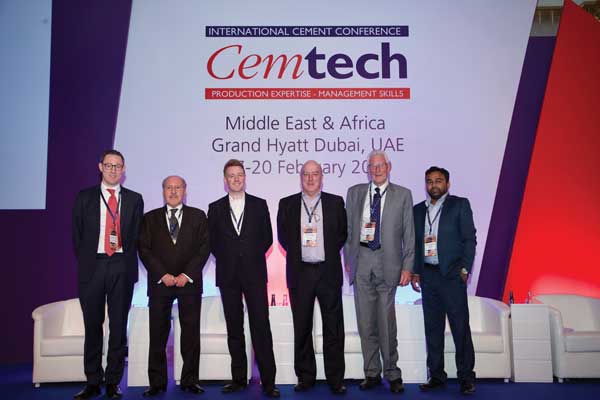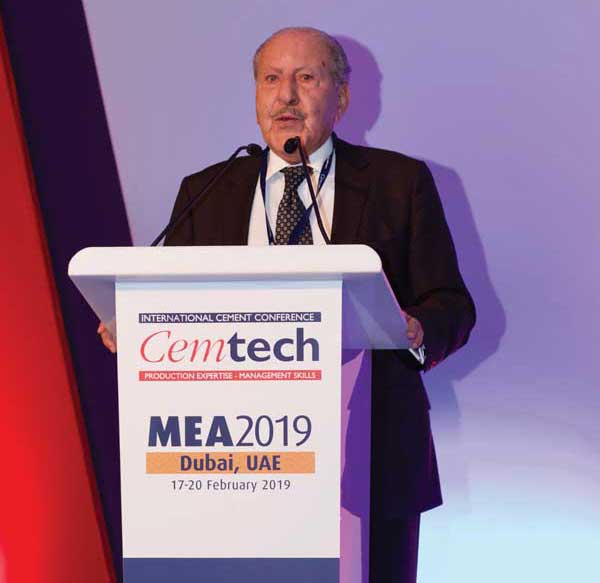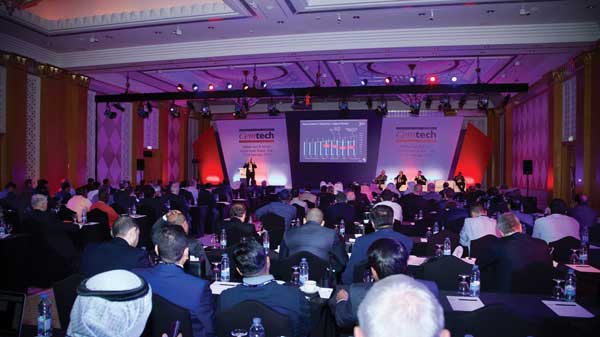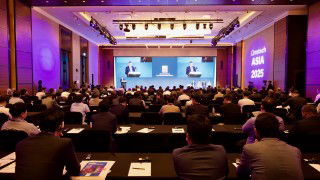Over 200 delegates from the global cement industry came together for Cemtech Middle East & Africa 2019, held at the Grand Hyatt Dubai between 17-20 February. The event featured an extensive technical programme alongside an international exhibition of service and product suppliers.

The first session speakers – from left to right: Thomas Armstrong, ICR; Ahmad Al-Rousan, AUCBM; Paul Roger, Exane
BNP Paribas; Tony Hadley, Tony Hadley African Advisory; Keith Hall, chairman and Hettish Karmani, U-Capital
Guest of honour, Eng Ahmad Al-Rousan, secretary general, Arab Union for Cement and Building Materials (AUCBM), delivered a welcome address to begin the Cemtech MEA 2019 conference programme. Mr Al-Rousan noted that the event “is coming in a time when the cement industry is facing a very big change and big problems.” In total, AUCBM member countries have 175 integrated plants and over 30 grinding mills, delivering a cement capacity of 353Mta. However, actual production for 2018 was 240Mt. One of the major factors contributing to this supply-demand gap are the ongoing wars in some of its member countries. Mr Al-Rousan stated that “this conference is very important to exchange experience and to discuss all of these problems [...] and to see what we want to happen in the future”.

AUCBM Secretary General, Ahmad Al-Rousan,
delivers the opening address
International Cement Review’s Managing Director, Thomas Armstrong, also considered how oversupply remains the dominant issue facing the cement sector in the Middle East and African region, with a 55-60 per cent capacity utilisation rate in 2017. The options for cement producers are clear: export the surplus and optimise your operations to remain profitable in an increasingly competitive environment. These topics remained the focus of discussion over the coming two days.
Global outlook
Paul Roger, Exane BNP Paribas (UK), delivered a demand and pricing outlook for global cement markets over the 2019-22 period. Mr Roger, who expects worldwide dement to grow by 2.8 per cent (excluding China) in 2019, outlined some of the most important issues that producers will face in the medium-term. These include the impact of tighter environmental regulations, expansion of Chinese groups overseas, low-cost equipment reducing barriers to entry and consolidation after mergers such as Lafarge-Holcim and Heidelberg-Italcementi have reshaped the industry.
Overcapacity markets
Tony Hadley delivered an analysis and outlook of the cement sector in the sub-Saharan and northern regions of Africa. As such, Mr Hadley reflected that previously “We have talked about the turmoil and that has probably come to a head in many parts of Africa.” In emerging markets large overcapacity has led to some producers altogether leaving the market and moving to more-established regions. Meanwhile, new entrants are expanding capacity at too fast a pace and consequently crashing prices. Looking ahead it seems more likely that larger multinationals will move away from mergers and acquisitions to focus on internal development strategies.
Hettish Karmani, U-Capital (Oman), looked at corporate performance in GCC markets and gave an outlook for the region in 2019. In terms of economic performance, the GCC region is expected to record around 3.9 per cent GDP growth in 2019. While total installed capacity of the cement sector is still expected to increase slightly, as a whole capacity growth is expected to slow considerably as a result of oversupply. However, demand is expected to show minor growth compared to 2018 and reach 81Mt in 2019.
Seyed Parhizgar of Khalagh Tadbir Pars Co (Iran) presented a market report for the Iranian cement industry, which recorded 58.1Mt of cement production in 2018. This figure was a slight increase from the 57.5Mt recorded in the previous year. However, capacity reached 85Mta in 2017 and did not increase into 2018. This still leaves a significant amount of overcapacity and an underperforming utilisation rate. Mr Parhizgar noted that cement exports, the usual solution to this issue, are one method which the industry is using to deal with overcapacity. Nevertheless, competition is high and Iranian cement and clinker exports have been falling since a high of 18.9Mt was recorded in 2014, declining to 12Mt in 2018. However, it is hoped that Iran’s high-quality raw materials and competitive pricing will enable it to remain competitive in international markets.
Plant tour |
|
The conference programme included a plant tour to Arkan Building Materials’ 4.5Mta facility in Al Ain on Wednesday, 20 February. The facility was constructed by Sinoma in 2012 and features a five-stage, twin-string preheater and 10,000tpd kiln. Two Loesche LM60.6 vertical raw mills grind raw material at a capacity of 400tph, while cement grinding is carried out by three additional LM56.3+3C/S mills at a capacity of 210tph. 
Delegates visit Arkan Building Materials |
Solutions and technical progress
In terms of trade in MEA, Javier Martínez of GlobBulk Consulting (Spain) examined clinker exports and the potential of Algeria as an export market. After a period where consumption outpaced the amount which domestic suppliers could produce, the country is now ready to export. Mr Martínez explored how high capacity and suitable distances from plant to port mean that around 8Mta of cement exports could feasibly be achieved in the future. However, it is essential that the industry uses logistics experts to design suitable export operations, whilst port infrastructure is upgraded.
Pritish Devassy, Al Rajhi Capital (Saudi Arabia), provided an economic context for the cement sector in Saudi Arabia and considered methods which could stabilise the industry in the country and reduce the gap between demand and supply. Solutions consisted of shutting down old capacity alongside potential mergers and acquisitions between players. However, Mr Devassy also suggested that it may be more profitable to start a new company, rather than buying an established one through the open market. Finally, although it would likely be financed by players external to the country, planned mega-projects such as Neom provide a positive outlook for cement demand.
Moving on to sustainability in north Africa, Giuseppe Colaiacovo, vice-president of Italy’s Colacem SpA, spoke about the company’s operations in Tunisia. After acquiring Les Ciments Artificiels Tunisiens (CAT) in 2000, Colacem quickly set to work on improving sustainability at the plant. Since the country is the largest producer of olive oil outside of the EU, the company has partially substituted fossil fuels with waste from this booming industry. In 2018 the company managed a substitution rate of 10.9 per cent, saving 20,000t of CO2 emissions over the year.

Delegates listen intently to one of the main presentations in the conference hall
Programme highlights and manufacturing trends
Peter Hoddinott highlighted the important issue of health and safety leadership in cement manufacturing. Across the industry there are approximately 500 fatalities and over 50,000 lost-time injuries per year, a figure that is gradually improving. Mr Hoddinott noted how leading factors such as near-miss reports and feedback alongside training hours are the most effective methods to monitor and improve health and safety in cement plant operations. Furthermore, the good leadership required for health and safety has been linked to soaring financial results.
The theme of the importance of health and safety was picked up by further presentations such as UAE-based Stevin Rock, which highlighted it as one of the company’s main priorities. The focus of the presentation was the large limestone reserves of the UAE, with the company’s Khor Khuwair quarry having reserves of over 2.5bnt alone. As one of the world’s largest quarries, it supplies 60Mta of finished products through various channels. In particular, it is located next to Saqr port, which is amongst the biggest in the MENA region and can process over 50Mta of cargo. However, another berth will be commissioned in March 2019 to expand it to 80Mta. Products are currently exported to GCC countries, India and Madagascar amongst others, while domestically its materials have been instrumental in the construction of various projects such as the Burj Khalifa, Dubai airport and Palm Jumeirah island.
DG Khan’s Arif Bashir (Pakistan) presented a case study of the construction and commissioning of Pakistan’s largest cement facility at 9000tpd. Alongside this project, cement capacity in the country is expected to rise from 48Mta in 2018 to 63.26Mta in 2019. Providing a background for the new capacity, Dr Bashir stated that the reason the “cement industry is growing in the country is because there are a lot of interesting projects coming up”, with China alone investing around US$68bn in new infrastructure projects.
InterCem Engineering looked at the growing trend for modular grinding plants, describing its role as supplier to the first European network of regional grinding plants. The facilities can be dropped into the centre of high-demand markets due to their modular qualities and can be set up quickly at a relatively small investment. The facilities are placed at strategic locations to benefit from rail links or river ports. For further information, see ICR February 2019, which covered the commissioning of the first of these facilities.
Another presentation highlight was delivered by Robert Feldmann, McKinsey & Co (Germany), who picked up on the increasingly important theme of digital transformation and AI. Mr Feldmann showed the results of a case study that may have been the world’s first fully-autonomous AI asset optimiser for a vertical raw mill and kiln in a cement plant. At the end of a 24-month process, the system resulted in a 12 per cent performance boost compared to the manual mode. For the full report on the project, see ICR February 2019.
Cemtech Awards |
|
This year three outstanding presentations from the programme were recognised at the Gala Dinner that celebrates the successful conclusion of the conference. The winners for Cemtech MEA 2019 were: The prizes were awarded by AUCBM Secretary General, Mr Al-Rousan. 
The Cemtech awards – from left to right: Arif Bashir, DG Khan; Ahmad Al-Rousan, AUCBM; Robert Feldman, McKinsey & Co; Thomas Armstrong, ICR, and Peter Hoddinott, Peter Hoddinott Consulting |
Exhibition
The event included a 22-stand exhibition, highlighting the latest manufacturing solutions from international and regional technology suppliers. Cemtech MEA 2019 included suppliers from a range of areas, including milling, online analysers, silo explosion protection, bagging/packaging, clinker coolers and logistics.
Cemtech 2019 schedule
While Cemtech MEA 2019 has now concluded, Cemtech events for the rest of the year have been announced.
Cemtech Asia 2019
Cemtech Asia will be held at Avani+ Riverside Hotel in Bangkok, Thailand, between 16-19 June, sponsored by SCG (Thailand).
The conference theme is: ‘Cement in Asia – pathways to a low-carbon future’. The technical programme will focus on low-carbon technologies, while also examining the full spectrum of cement manufacturing technology.
This event will also feature an exhibition of international product and service suppliers.
Cemtech Europe 2019
This year Cemtech Europe will be held at the InterContinental Hotel in Berlin, Germany, between 30 September-3 October. Send speaker proposals and exhibition enquiries to info@cemtech.com.
This article was first published in International Cement Review in April 2019.
